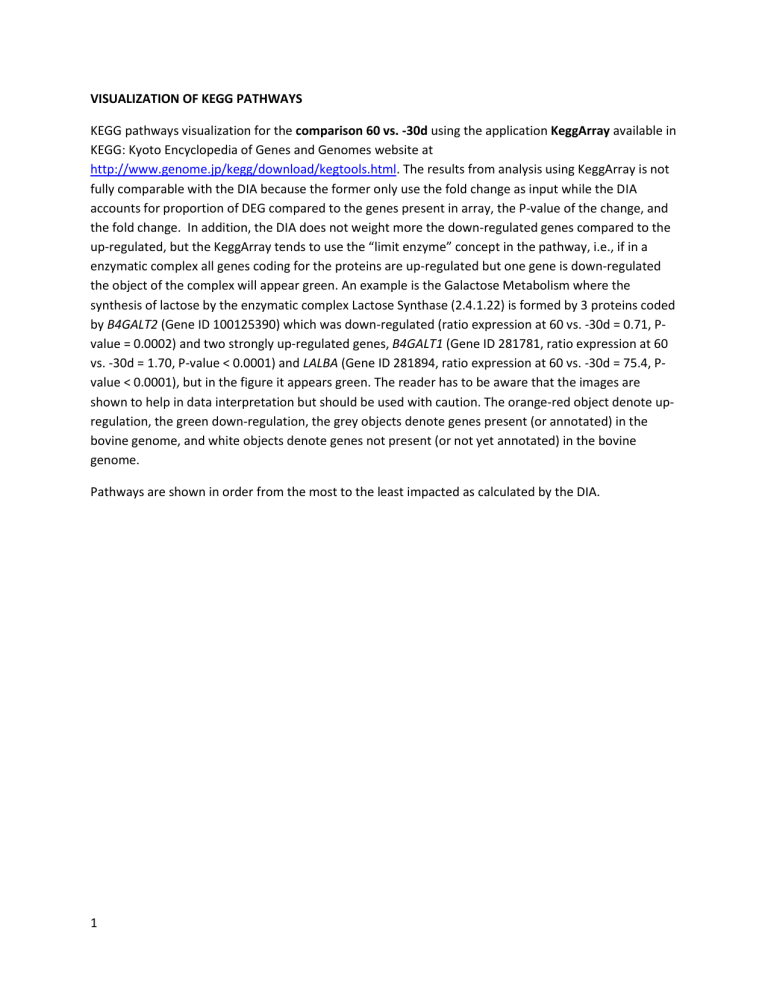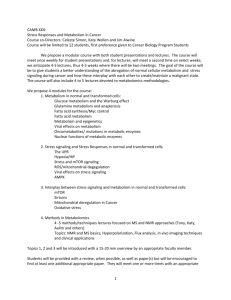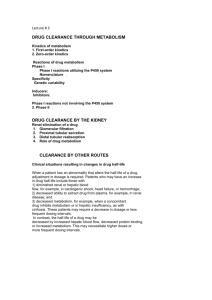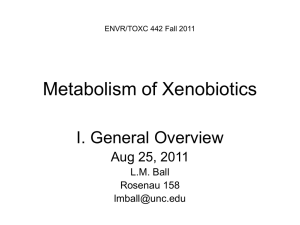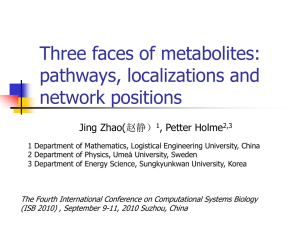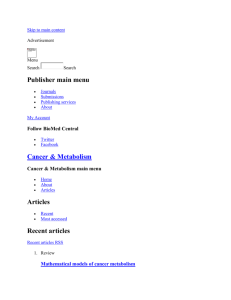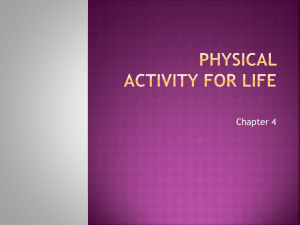VISUALIZATION OF KEGG PATHWAYS
KEGG pathways visualization for the comparison 60 vs. -30d using the application KeggArray available in
KEGG: Kyoto Encyclopedia of Genes and Genomes website at http://www.genome.jp/kegg/download/kegtools.html
. The results from analysis using KeggArray is not fully comparable with the DIA because the former only use the fold change as input while the DIA accounts for proportion of DEG compared to the genes present in array, the P-value of the change, and the fold change. In addition, the DIA does not weight more the down-regulated genes compared to the up-regulated, but the KeggArray tends to use the “limit enzyme” concept in the pathway, i.e., if in a enzymatic complex all genes coding for the proteins are up-regulated but one gene is down-regulated the object of the complex will appear green. An example is the Galactose Metabolism where the synthesis of lactose by the enzymatic complex Lactose Synthase (2.4.1.22) is formed by 3 proteins coded by B4GALT2 (Gene ID 100125390) which was down-regulated (ratio expression at 60 vs. -30d = 0.71, Pvalue = 0.0002) and two strongly up-regulated genes, B4GALT1 (Gene ID 281781, ratio expression at 60 vs. -30d = 1.70, P-value < 0.0001) and LALBA (Gene ID 281894, ratio expression at 60 vs. -30d = 75.4, Pvalue < 0.0001), but in the figure it appears green. The reader has to be aware that the images are shown to help in data interpretation but should be used with caution. The orange-red object denote upregulation, the green down-regulation, the grey objects denote genes present (or annotated) in the bovine genome, and white objects denote genes not present (or not yet annotated) in the bovine genome.
Pathways are shown in order from the most to the least impacted as calculated by the DIA.
1
Contents
METABOLIC PATHWAYS .............................................................................................................................. 10
1.Metabolism; ............................................................................................................................................. 11
1.1 Carbohydrate Metabolism ................................................................................................................ 11
Amino sugar and nucleotide sugar metabolism ................................................................................. 11
Ascorbate and aldarate metabolism ................................................................................................... 12
Butanoate Metabolism ....................................................................................................................... 13
Citrate cycle (TCA) ............................................................................................................................... 14
Fructose and Mannose Metabolism ................................................................................................... 15
Galactose Metabolism ........................................................................................................................ 16
Glycolysis / Gluconeogenesis .............................................................................................................. 17
Glyoxylate and dicarboxylate metabolism .......................................................................................... 18
Inositol phosphate metabolism .......................................................................................................... 19
Pentose and glucuronate interconversions ........................................................................................ 20
Pentose phosphate pathway .............................................................................................................. 21
Propanoate metabolism ..................................................................................................................... 22
Pyruvate metabolism .......................................................................................................................... 23
Starch and sucrose metabolism .......................................................................................................... 24
1.Metabolism .............................................................................................................................................. 25
1.2 Energy Metabolism ........................................................................................................................... 25
Nitrogen metabolism .......................................................................................................................... 25
Oxidative phosphorylation .................................................................................................................. 26
Sulfur metabolism ............................................................................................................................... 27
1. Metabolism ............................................................................................................................................. 28
1.3 Lipid Metabolism .............................................................................................................................. 28 alpha-Linolenic acid metabolism ........................................................................................................ 28
Arachidonic acid metabolism .............................................................................................................. 29
Biosynthesis of unsaturated fatty acids .............................................................................................. 30
Ether lipid metabolism ........................................................................................................................ 31
Fatty acid biosynthesis ........................................................................................................................ 32
Fatty acid elongation in mitochondria ................................................................................................ 33
Fatty acid metabolism ......................................................................................................................... 34
2
Glycerolipid metabolism ..................................................................................................................... 35
Glycerophospholipid metabolism ....................................................................................................... 36
Primary bile acid biosynthesis ............................................................................................................. 37
Sphingolipid metabolism .................................................................................................................... 38
Steroid biosynthesis ............................................................................................................................ 39
Steroid hormone biosynthesis ............................................................................................................ 40
Synthesis and degradation of ketone bodies ...................................................................................... 41
1. Metabolism ............................................................................................................................................. 42
1.4 Nucleotide Metabolism..................................................................................................................... 42
Purine metabolism .............................................................................................................................. 42
Pyrimidine metabolism ....................................................................................................................... 43
1. Metabolism ............................................................................................................................................. 44
1.5 Amino Acid Metabolism .................................................................................................................... 44
Alanine, aspartate and glutamate metabolism .................................................................................. 44
Arginine and proline metabolism ....................................................................................................... 45
Cysteine and methionine metabolism ................................................................................................ 46
Glycine, serine and threonine metabolism ......................................................................................... 47
Histidine metabolism .......................................................................................................................... 48
Lysine degradation .............................................................................................................................. 49
Phenylalanine metabolism .................................................................................................................. 50
Tryptophan metabolism...................................................................................................................... 51
Tyrosine metabolism ........................................................................................................................... 52
Valine, leucine and isoleucine biosynthesis ........................................................................................ 53
Valine, leucine and isoleucine degradation ........................................................................................ 54
1. Metabolism ............................................................................................................................................. 55
1.6 Metabolism of Other Amino Acids .................................................................................................... 55 beta-Alanine metabolism .................................................................................................................... 55
Cyanoamino acid metabolism ............................................................................................................. 56
Glutathione metabolism ..................................................................................................................... 57
Taurine and hypotaurine metabolism ................................................................................................ 58
1. Metabolism ............................................................................................................................................. 59
1.7 Glycan Biosynthesis and Metabolism ............................................................................................... 59
3
Glycosaminoglycan biosynthesis - chondroitin sulfate ....................................................................... 59
Glycosaminoglycan biosynthesis - keratan sulfate ............................................................................. 60
Glycosaminoglycan degradation ......................................................................................................... 61
Glycosphingolipid biosynthesis - ganglio series .................................................................................. 62
Glycosphingolipid biosynthesis - globo series .................................................................................... 63
Glycosphingolipid biosynthesis - lacto and neolacto series ................................................................ 64
Glycosylphosphatidylinositol(GPI)-anchor biosynthesis ..................................................................... 65
N-Glycan biosynthesis ......................................................................................................................... 66
O-Glycan biosynthesis ......................................................................................................................... 67
Other glycan degradation ................................................................................................................... 68
1. Metabolism ............................................................................................................................................. 69
1.8 Metabolism of Cofactors and Vitamins ............................................................................................ 69
Biotin metabolism ............................................................................................................................... 69
Folate biosynthesis ............................................................................................................................. 70
Nicotinate and nicotinamide metabolism .......................................................................................... 71
One carbon pool by folate .................................................................................................................. 72
Pantothenate and CoA biosynthesis ................................................................................................... 73
Porphyrin and chlorophyll metabolism .............................................................................................. 74
Retinol metabolism ............................................................................................................................. 75
Riboflavin metabolism ........................................................................................................................ 76
Thiamine metabolism ......................................................................................................................... 77
Vitamin B6 metabolism ....................................................................................................................... 78
1. Metabolism ............................................................................................................................................. 79
1.9 Metabolism of Terpenoids and Polyketides ..................................................................................... 79
Terpenoid backbone biosynthesis ...................................................................................................... 79
1. Metabolism ............................................................................................................................................. 80
1.10 Biosynthesis of Other Secondary Metabolites ................................................................................ 80
Caffeine metabolism ........................................................................................................................... 80
1. Metabolism ............................................................................................................................................. 81
1.11 Xenobiotics Biodegradation and Metabolism................................................................................. 81
Drug metabolism - cytochrome P450 ................................................................................................. 81
Drug metabolism - other enzymes ...................................................................................................... 82
4
Metabolism of xenobiotics by cytochrome P450 ............................................................................... 83
2. Genetic Information Processing .............................................................................................................. 84
2.1 Transcription ..................................................................................................................................... 84
Basal transcription factors .................................................................................................................. 84
RNA polymerase .................................................................................................................................. 85
Spliceosome ........................................................................................................................................ 86
2. Genetic Information Processing .............................................................................................................. 87
2.2 Translation ........................................................................................................................................ 87
Aminoacyl-tRNA biosynthesis ............................................................................................................. 87
mRNA surveillance pathway ............................................................................................................... 88
Ribosome ............................................................................................................................................ 89
Ribosome biogenesis in eukaryotes .................................................................................................... 90
RNA transport ..................................................................................................................................... 91
2. Genetic Information Processing .............................................................................................................. 92
2.3 Folding, Sorting and Degradation ..................................................................................................... 92
Proteasome ......................................................................................................................................... 92
Protein export ..................................................................................................................................... 93
Protein processing in endoplasmic reticulum ..................................................................................... 94
RNA degradation ................................................................................................................................. 95
SNARE interactions in vesicular transport .......................................................................................... 96
Sulfur relay system .............................................................................................................................. 97
Ubiquitin mediated proteolysis .......................................................................................................... 98
2. Genetic Information Processing .............................................................................................................. 99
2.4 Replication and Repair ...................................................................................................................... 99
Base excision repair ............................................................................................................................ 99
DNA replication ................................................................................................................................. 100
Homologous recombination ............................................................................................................. 101
Mismatch repair ................................................................................................................................ 102
Non-homologous end-joining ........................................................................................................... 103
Nucleotide excision repair ................................................................................................................ 104
3. Environmental Information Processing ................................................................................................ 105
3.1 Membrane Transport ...................................................................................................................... 105
5
ABC transporters ............................................................................................................................... 105
3. Environmental Information Processing ................................................................................................ 106
3.2 Signal Transduction ..................................................................................................................... 106
Calcium signaling pathway ................................................................................................................ 106
ErbB signaling pathway ..................................................................................................................... 107
Hedgehog signaling pathway ............................................................................................................ 108
Jak-STAT signaling pathway .............................................................................................................. 109
MAPK signaling pathway ................................................................................................................... 110
mTOR signaling pathway ................................................................................................................... 111
Notch signaling pathway ................................................................................................................... 112
Phosphatidylinositol signaling system .............................................................................................. 113
TGF-beta signaling pathway .............................................................................................................. 114
VEGF signaling pathway .................................................................................................................... 115
Wnt signaling pathway ...................................................................................................................... 116
3. Environmental Information Processing ................................................................................................ 117
3.3 Signaling Molecules and Interaction ............................................................................................... 117
Cell adhesion molecules (CAMs) ....................................................................................................... 117
Cytokine-cytokine receptor interaction ............................................................................................ 118
ECM-receptor interaction ................................................................................................................. 119
4. Cellular Processes ................................................................................................................................. 120
4.1 Transport and Catabolism ............................................................................................................... 120
Endocytosis ....................................................................................................................................... 120
Lysosome........................................................................................................................................... 121
Peroxisome ....................................................................................................................................... 122
Phagosome ........................................................................................................................................ 123
Regulation of autophagy ................................................................................................................... 124
4. Cellular Processes ................................................................................................................................. 125
4.2 Cell Motility ..................................................................................................................................... 125
Regulation of actin cytoskeleton ...................................................................................................... 125
4. Cellular Processes ................................................................................................................................. 126
4.3 Cell Growth and Death .................................................................................................................... 126
Apoptosis .......................................................................................................................................... 126
6
Cell cycle ............................................................................................................................................ 127
Oocyte meiosis .................................................................................................................................. 128
p53 signaling pathway ...................................................................................................................... 129
4. Cellular Processes ................................................................................................................................. 130
4.4 Cell Communication ........................................................................................................................ 130
Adherens junction ............................................................................................................................. 130
Focal adhesion .................................................................................................................................. 131
Gap junction ...................................................................................................................................... 132
Tight junction .................................................................................................................................... 133
5. Organismal Systems .............................................................................................................................. 134
5.1 Immune System .............................................................................................................................. 134
Antigen processing and presentation ............................................................................................... 134
B cell receptor signaling pathway ..................................................................................................... 135
Chemokine signaling pathway .......................................................................................................... 136
Complement and coagulation cascades ........................................................................................... 137
Cytosolic DNA-sensing pathway........................................................................................................ 138
Fc epsilon RI signaling pathway ........................................................................................................ 139
Fc gamma R-mediated phagocytosis ................................................................................................ 140
Hematopoietic cell lineage ............................................................................................................... 141
Intestinal immune network for IgA production ................................................................................ 142
Leukocyte transendothelial migration .............................................................................................. 143
Natural killer cell mediated cytotoxicity ........................................................................................... 144
NOD-like receptor signaling pathway ............................................................................................... 145
RIG-I-like receptor signaling pathway ............................................................................................... 146
T cell receptor signaling pathway ..................................................................................................... 147
Toll-like receptor signaling pathway ................................................................................................. 148
5. Organismal Systems .............................................................................................................................. 149
5.2 Endocrine System ............................................................................................................................ 149
Adipocytokine signaling pathway ..................................................................................................... 149
GnRH signaling pathway ................................................................................................................... 150
Insulin signaling pathway .................................................................................................................. 151
Melanogenesis .................................................................................................................................. 152
7
PPAR signaling pathway .................................................................................................................... 153
Progesterone-mediated oocyte maturation ..................................................................................... 154
Renin-angiotensin system ................................................................................................................. 155
5. Organismal Systems .............................................................................................................................. 156
5.3 Circulatory System .......................................................................................................................... 156
Cardiac muscle contraction ............................................................................................................... 156
Vascular smooth muscle contraction ................................................................................................ 157
5. Organismal Systems .............................................................................................................................. 158
5.4 Digestive System ............................................................................................................................. 158
Bile secretion ..................................................................................................................................... 158
Carbohydrate digestion and absorption ........................................................................................... 159
Fat digestion and absorption ............................................................................................................ 160
Gastric acid secretion ........................................................................................................................ 161
Mineral absorption ........................................................................................................................... 162
Pancreatic secretion .......................................................................................................................... 163
Protein digestion and absorption ..................................................................................................... 164
Salivary secretion .............................................................................................................................. 165
Vitamin digestion and absorption ..................................................................................................... 166
5. Organismal Systems .............................................................................................................................. 167
5.5 Excretory System............................................................................................................................. 167
Aldosterone-regulated sodium reabsorption ................................................................................... 167
Collecting duct acid secretion ........................................................................................................... 168
Endocrine and other factor-regulated calcium reabsorption ........................................................... 169
Proximal tubule bicarbonate reclamation ........................................................................................ 170
Vasopressin-regulated water reabsorption ...................................................................................... 171
5. Organismal Systems .............................................................................................................................. 172
5.6 Nervous System .............................................................................................................................. 172
Glutamatergic synapse...................................................................................................................... 172
Long-term depression ....................................................................................................................... 173
Long-term potentiation..................................................................................................................... 174
Neurotrophin signaling pathway ...................................................................................................... 175
5. Organismal Systems .............................................................................................................................. 176
8
5.7 Sensory System ............................................................................................................................... 176
Phototransduction ............................................................................................................................ 176
5. Organismal Systems .............................................................................................................................. 177
5.8 Development ................................................................................................................................... 177
Axon guidance ................................................................................................................................... 177
Dorso-ventral axis formation ............................................................................................................ 178
Osteoclast differentiation ................................................................................................................. 179
5. Organismal Systems .............................................................................................................................. 180
5.9 Environmental Adaptation .............................................................................................................. 180
Circadian rhythm - mammal ............................................................................................................. 180
9
METABOLIC PATHWAYS
Orange line denote positive or increased flux and light green lines decreased flux. Other color lines denote the overall category of pathways
10
1.Metabolism;
1.1 Carbohydrate Metabolism
Amino sugar and nucleotide sugar metabolism
11
Ascorbate and aldarate metabolism
12
Butanoate Metabolism
13
Citrate cycle (TCA)
14
Fructose and Mannose Metabolism
15
Galactose Metabolism
16
Glycolysis / Gluconeogenesis
17
Glyoxylate and dicarboxylate metabolism
18
Inositol phosphate metabolism
19
Pentose and glucuronate interconversions
20
Pentose phosphate pathway
21
Propanoate metabolism
22
Pyruvate metabolism
23
Starch and sucrose metabolism
24
1.Metabolism
1.2 Energy Metabolism
Nitrogen metabolism
25
Oxidative phosphorylation
26
Sulfur metabolism
27
1. Metabolism
1.3 Lipid Metabolism alpha-Linolenic acid metabolism
28
Arachidonic acid metabolism
29
Biosynthesis of unsaturated fatty acids
30
Ether lipid metabolism
31
Fatty acid biosynthesis
32
Fatty acid elongation in mitochondria
33
Fatty acid metabolism
34
Glycerolipid metabolism
35
Glycerophospholipid metabolism
36
Primary bile acid biosynthesis
37
Sphingolipid metabolism
38
Steroid biosynthesis
39
Steroid hormone biosynthesis
40
Synthesis and degradation of ketone bodies
41
1. Metabolism
1.4 Nucleotide Metabolism
Purine metabolism
42
Pyrimidine metabolism
43
1. Metabolism
1.5 Amino Acid Metabolism
Alanine, aspartate and glutamate metabolism
44
Arginine and proline metabolism
45
Cysteine and methionine metabolism
46
Glycine, serine and threonine metabolism
47
Histidine metabolism
48
Lysine degradation
49
Phenylalanine metabolism
50
Tryptophan metabolism
51
Tyrosine metabolism
52
Valine, leucine and isoleucine biosynthesis
53
Valine, leucine and isoleucine degradation
54
1. Metabolism
1.6 Metabolism of Other Amino Acids beta-Alanine metabolism
55
Cyanoamino acid metabolism
56
Glutathione metabolism
57
Taurine and hypotaurine metabolism
58
1. Metabolism
1.7 Glycan Biosynthesis and Metabolism
Glycosaminoglycan biosynthesis - chondroitin sulfate
59
Glycosaminoglycan biosynthesis - keratan sulfate
60
Glycosaminoglycan degradation
61
Glycosphingolipid biosynthesis - ganglio series
62
Glycosphingolipid biosynthesis - globo series
63
Glycosphingolipid biosynthesis - lacto and neolacto series
64
Glycosylphosphatidylinositol(GPI)-anchor biosynthesis
65
N-Glycan biosynthesis
66
O-Glycan biosynthesis
67
Other glycan degradation
68
1. Metabolism
1.8 Metabolism of Cofactors and Vitamins
Biotin metabolism
69
Folate biosynthesis
70
Nicotinate and nicotinamide metabolism
71
One carbon pool by folate
72
Pantothenate and CoA biosynthesis
73
Porphyrin and chlorophyll metabolism
74
Retinol metabolism
75
Riboflavin metabolism
76
Thiamine metabolism
77
Vitamin B6 metabolism
78
1. Metabolism
1.9 Metabolism of Terpenoids and Polyketides
Terpenoid backbone biosynthesis
79
1. Metabolism
1.10 Biosynthesis of Other Secondary Metabolites
Caffeine metabolism
80
1. Metabolism
1.11 Xenobiotics Biodegradation and Metabolism
Drug metabolism - cytochrome P450
81
Drug metabolism - other enzymes
82
Metabolism of xenobiotics by cytochrome P450
83
2. Genetic Information Processing
2.1 Transcription
Basal transcription factors
84
RNA polymerase
85
Spliceosome
86
2. Genetic Information Processing
2.2 Translation
Aminoacyl-tRNA biosynthesis
87
mRNA surveillance pathway
88
Ribosome
89
Ribosome biogenesis in eukaryotes
90
RNA transport
91
2. Genetic Information Processing
2.3 Folding, Sorting and Degradation
Proteasome
92
Protein export
93
Protein processing in endoplasmic reticulum
94
RNA degradation
95
SNARE interactions in vesicular transport
96
Sulfur relay system
97
Ubiquitin mediated proteolysis
98
2. Genetic Information Processing
2.4 Replication and Repair
Base excision repair
99
DNA replication
100
Homologous recombination
101
Mismatch repair
102
Non-homologous end-joining
103
Nucleotide excision repair
104
3. Environmental Information Processing
3.1 Membrane Transport
ABC transporters
105
3. Environmental Information Processing
3.2 Signal Transduction
Calcium signaling pathway
106
ErbB signaling pathway
107
Hedgehog signaling pathway
108
Jak-STAT signaling pathway
109
MAPK signaling pathway
110
mTOR signaling pathway
111
Notch signaling pathway
112
Phosphatidylinositol signaling system
113
TGF-beta signaling pathway
114
VEGF signaling pathway
115
Wnt signaling pathway
116
3. Environmental Information Processing
3.3 Signaling Molecules and Interaction
Cell adhesion molecules (CAMs)
117
Cytokine-cytokine receptor interaction
118
ECM-receptor interaction
119
4. Cellular Processes
4.1 Transport and Catabolism
Endocytosis
120
Lysosome
121
Peroxisome
122
Phagosome
123
Regulation of autophagy
124
4. Cellular Processes
4.2 Cell Motility
Regulation of actin cytoskeleton
125
4. Cellular Processes
4.3 Cell Growth and Death
Apoptosis
126
Cell cycle
127
Oocyte meiosis
128
p53 signaling pathway
129
4. Cellular Processes
4.4 Cell Communication
Adherens junction
130
Focal adhesion
131
Gap junction
132
Tight junction
133
5. Organismal Systems
5.1 Immune System
Antigen processing and presentation
134
B cell receptor signaling pathway
135
Chemokine signaling pathway
136
Complement and coagulation cascades
137
Cytosolic DNA-sensing pathway
138
Fc epsilon RI signaling pathway
139
Fc gamma R-mediated phagocytosis
140
Hematopoietic cell lineage
141
Intestinal immune network for IgA production
(the pathway shows many genes up-regulated, but in reality most of those genes are actually down-regulated. This was a problem with KEGG array that was not possible to solve)
142
Leukocyte transendothelial migration
143
Natural killer cell mediated cytotoxicity
144
NOD-like receptor signaling pathway
145
RIG-I-like receptor signaling pathway
146
T cell receptor signaling pathway
147
Toll-like receptor signaling pathway
148
5. Organismal Systems
5.2 Endocrine System
Adipocytokine signaling pathway
149
GnRH signaling pathway
150
Insulin signaling pathway
151
Melanogenesis
152
PPAR signaling pathway
153
Progesterone-mediated oocyte maturation
154
Renin-angiotensin system
155
5. Organismal Systems
5.3 Circulatory System
Cardiac muscle contraction
156
Vascular smooth muscle contraction
157
5. Organismal Systems
5.4 Digestive System
Bile secretion
158
Carbohydrate digestion and absorption
159
Fat digestion and absorption
160
Gastric acid secretion
161
Mineral absorption
162
Pancreatic secretion
163
Protein digestion and absorption
164
Salivary secretion
165
Vitamin digestion and absorption
166
5. Organismal Systems
5.5 Excretory System
Aldosterone-regulated sodium reabsorption
167
Collecting duct acid secretion
168
Endocrine and other factor-regulated calcium reabsorption
169
Proximal tubule bicarbonate reclamation
170
Vasopressin-regulated water reabsorption
171
5. Organismal Systems
5.6 Nervous System
Glutamatergic synapse
172
Long-term depression
173
Long-term potentiation
174
Neurotrophin signaling pathway
175
5. Organismal Systems
5.7 Sensory System
Phototransduction
176
5. Organismal Systems
5.8 Development
Axon guidance
177
Dorso-ventral axis formation
178
Osteoclast differentiation
179
5. Organismal Systems
5.9 Environmental Adaptation
Circadian rhythm - mammal
180
